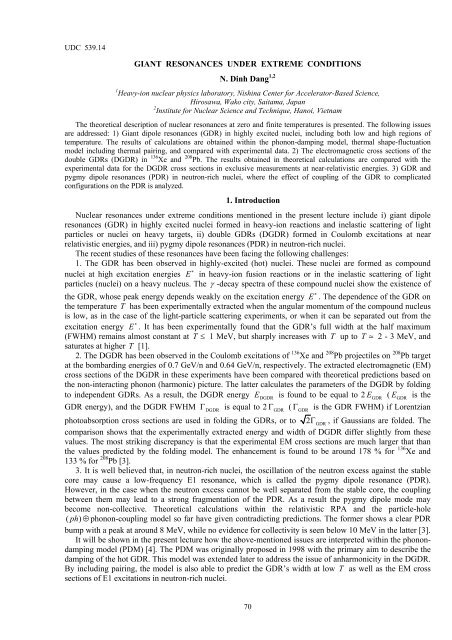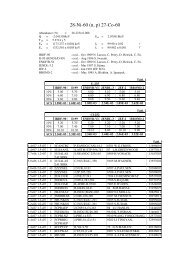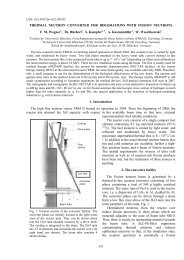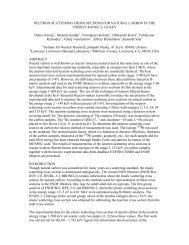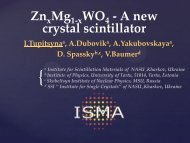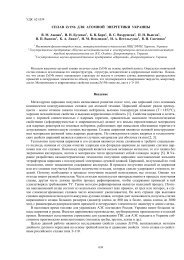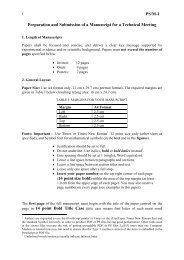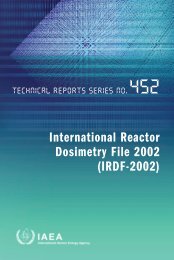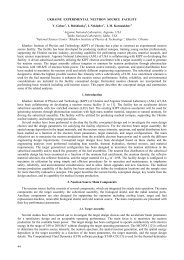Dinh Dang.pdf
Dinh Dang.pdf
Dinh Dang.pdf
Create successful ePaper yourself
Turn your PDF publications into a flip-book with our unique Google optimized e-Paper software.
UDC 539.14<br />
GIANT RESONANCES UNDER EXTREME CONDITIONS<br />
N. <strong>Dinh</strong> <strong>Dang</strong> 1,2<br />
1 Heavy-ion nuclear physics laboratory, Nishina Center for Accelerator-Based Science,<br />
Hirosawa, Wako city, Saitama, Japan<br />
2 Institute for Nuclear Science and Technique, Hanoi, Vietnam<br />
The theoretical description of nuclear resonances at zero and finite temperatures is presented. The following issues<br />
are addressed: 1) Giant dipole resonances (GDR) in highly excited nuclei, including both low and high regions of<br />
temperature. The results of calculations are obtained within the phonon-damping model, thermal shape-fluctuation<br />
model including thermal pairing, and compared with experimental data. 2) The electromagnetic cross sections of the<br />
double GDRs (DGDR) in 136 Xe and 208 Pb. The results obtained in theoretical calculations are compared with the<br />
experimental data for the DGDR cross sections in exclusive measurements at near-relativistic energies. 3) GDR and<br />
pygmy dipole resonances (PDR) in neutron-rich nuclei, where the effect of coupling of the GDR to complicated<br />
configurations on the PDR is analyzed.<br />
1. Introduction<br />
Nuclear resonances under extreme conditions mentioned in the present lecture include i) giant dipole<br />
resonances (GDR) in highly excited nuclei formed in heavy-ion reactions and inelastic scattering of light<br />
particles or nuclei on heavy targets, ii) double GDRs (DGDR) formed in Coulomb excitations at near<br />
relativistic energies, and iii) pygmy dipole resonances (PDR) in neutron-rich nuclei.<br />
The recent studies of these resonances have been facing the following challenges:<br />
1. The GDR has been observed in highly-excited (hot) nuclei. These nuclei are formed as compound<br />
nuclei at high excitation energies E ∗ in heavy-ion fusion reactions or in the inelastic scattering of light<br />
particles (nuclei) on a heavy nucleus. The γ -decay spectra of these compound nuclei show the existence of<br />
the GDR, whose peak energy depends weakly on the excitation energy E ∗ . The dependence of the GDR on<br />
the temperature T has been experimentally extracted when the angular momentum of the compound nucleus<br />
is low, as in the case of the light-particle scattering experiments, or when it can be separated out from the<br />
excitation energy E ∗ . It has been experimentally found that the GDR’s full width at the half maximum<br />
(FWHM) remains almost constant at T ≤ 1 MeV, but sharply increases with T up to T 2 - 3 MeV, and<br />
saturates at higher T [1].<br />
2. The DGDR has been observed in the Coulomb excitations of 136 Xe and 208 Pb projectiles on 208 Pb target<br />
at the bombarding energies of 0.7 GeV/n and 0.64 GeV/n, respectively. The extracted electromagnetic (EM)<br />
cross sections of the DGDR in these experiments have been compared with theoretical predictions based on<br />
the non-interacting phonon (harmonic) picture. The latter calculates the parameters of the DGDR by folding<br />
to independent GDRs. As a result, the DGDR energy E<br />
DGDR<br />
is found to be equal to 2 E GDR<br />
( E<br />
GDR<br />
is the<br />
GDR energy), and the DGDR FWHM Γ<br />
DGDR<br />
is equal to 2 Γ GDR<br />
( Γ<br />
GDR<br />
is the GDR FWHM) if Lorentzian<br />
photoabsorption cross sections are used in folding the GDRs, or to 2Γ<br />
GDR<br />
, if Gaussians are folded. The<br />
comparison shows that the experimentally extracted energy and width of DGDR differ slightly from these<br />
values. The most striking discrepancy is that the experimental EM cross sections are much larger that than<br />
the values predicted by the folding model. The enhancement is found to be around 178 % for 136 Xe and<br />
133 % for 208 Pb [3].<br />
3. It is well believed that, in neutron-rich nuclei, the oscillation of the neutron excess against the stable<br />
core may cause a low-frequency E1 resonance, which is called the pygmy dipole resonance (PDR).<br />
However, in the case when the neutron excess cannot be well separated from the stable core, the coupling<br />
between them may lead to a strong fragmentation of the PDR. As a result the pygmy dipole mode may<br />
become non-collective. Theoretical calculations within the relativistic RPA and the particle-hole<br />
( ph)<br />
⊕ phonon-coupling model so far have given contradicting predictions. The former shows a clear PDR<br />
bump with a peak at around 8 MeV, while no evidence for collectivity is seen below 10 MeV in the latter [3].<br />
It will be shown in the present lecture how the above-mentioned issues are interpreted within the phonondamping<br />
model (PDM) [4]. The PDM was originally proposed in 1998 with the primary aim to describe the<br />
damping of the hot GDR. This model was extended later to address the issue of anharmonicity in the DGDR.<br />
By including pairing, the model is also able to predict the GDR’s width at low T as well as the EM cross<br />
sections of E1 excitations in neutron-rich nuclei.<br />
70
2. Outline of the PDM<br />
A. Damping of hot GDR<br />
The quasiparticle representation of the PDM Hamiltonian [5] is obtained by adding the superfluid pairing<br />
interaction and expressing the particle ( p ) and hole ( h ) creation and destruction operators, a † s<br />
and a s<br />
( s = ph , ), in terms of the quasiparticle operators, α † s<br />
and α s<br />
, using the Bogolyubov’s canonical<br />
transformation. As a result, the PDM Hamiltonian for the description of E λ excitations can be written in<br />
spherical basis as<br />
∑ ∑<br />
H = E α α + ω b b +<br />
jm<br />
† †<br />
j jm jm λi λµ i λµ i<br />
λµ i<br />
λ −µ<br />
1 ( −)<br />
( λ ) ( + ) † ( −) † †<br />
+ ∑ f<br />
jj′ { ujj′ [ Ajj′ ( λµ ) Ajj′ ( λµ )] vjj′ [ Bjj′ ( λµ ) Bjj′<br />
( λµ )]}( bλµ i<br />
bλµ<br />
i<br />
)<br />
2 ˆ ∑ + + + + ,<br />
λ ′<br />
λµ i<br />
jj<br />
where ˆ λ = 2λ<br />
+ 1. The first term at the right-hand side (rhs) of Hamiltonian (1) corresponds to the<br />
independent-quasiparticle field. The second term stands for the phonon field described by phonon operators,<br />
†<br />
b λµ i<br />
and b λµ i<br />
, with multipolarity λ , which generate the harmonic collective vibrations such as GDR.<br />
Phonons are ideal bosons within the PDM, i.e. they have no fermion structure. The last term is the coupling<br />
between quasiparticle and phonon fields, which is responsible for the microscopic damping of collective<br />
excitations.<br />
In Eq. (1) the following standard notations are used<br />
∑ ∑ (2)<br />
A ( λµ ) = jmjm ′ ′ | λµ α α , B ( λµ ) =− ( −) j m jmj′ − m′<br />
| λµ α α ,<br />
† † † † ′ − ′<br />
†<br />
jj′ jm j′ m′ jj′ jm j′ m′<br />
mm′ mm′<br />
λ −µ<br />
with ( λµ ) ←→ ( −) ( λ − µ ). Functions ( +<br />
u )<br />
jj′ ≡ ujvj′ + vjuj′<br />
and ( −<br />
v )<br />
jj′ ≡ujuj′ − vjvj′<br />
are combinations of<br />
Bogolyubov’s u and v coefficients. The quasiparticle energy E<br />
j<br />
is calculated from the single-particle<br />
energy ε<br />
j<br />
as<br />
(1)<br />
E<br />
= ( ε − ε ) +∆ , ε ≡ε<br />
− Gv , (3)<br />
2 2 2<br />
j j F<br />
j j j<br />
where the pairing gap ∆ and the Fermi energy ε<br />
F<br />
are defined as solutions of the BCS equations. At T ≠ 0<br />
the thermal pairing gap ∆ ( T ) (or ∆ ( T )) is defined from the finite-temperature BCS (or modified BCS)<br />
equations (See section C below).<br />
The equation for the propagation of the GDR phonon, which is damped due to coupling to the<br />
quasiparticle field, is derived making use of the double-time Green’s function method (introduced by<br />
Bogolyubov and Tyablikov, and developed further by Zubarev). Following the standard procedure of<br />
deriving the equation for the double-time retarded Green’s function with respect to the Hamiltonian (1); one<br />
obtains a closed set of equations for the Green’s functions for phonon and quasiparticle propagators. Making<br />
the Fourier transform into the energy plane E , and expressing all the Green functions in the set in terms of<br />
the one-phonon propagation Green function, we obtain the equation for the latter, G ( E)<br />
, in the form<br />
λ i<br />
G<br />
λi<br />
1 1<br />
( E)<br />
= 2 π E −ω λ i<br />
−P λ i( E)<br />
,<br />
(4)<br />
where the explicit form of the polarization operator Pλ i<br />
( E)<br />
is<br />
( + ) 2 ( −) 2<br />
( u<br />
( ) 2 jj<br />
) (1 nj nj )(<br />
j j<br />
) ( vjj ) ( nj nj )(<br />
j j<br />
)<br />
λ ′ − − ′ ε + ε ′ ′ − ′ ε −ε<br />
′<br />
2 jj′<br />
2 2 2 2<br />
jj′ E − ε<br />
j<br />
+ ε<br />
j′ E − ε<br />
j<br />
−ε<br />
j′<br />
1<br />
Pλ<br />
i( E) = ∑ [ f ] [ − ].<br />
(5)<br />
ˆ λ<br />
( ) ( )<br />
The polarization operator (5) appears due to ph – phonon coupling in the last term of the rhs of<br />
Hamiltonian (1). The phonon damping γ ( ω ) (ω real) is obtained as the imaginary part of the analytic<br />
λi<br />
71
continuation of the polarization operator Pλ i<br />
( E)<br />
into the complex energy plane E = ω ± iε<br />
. Its final form is<br />
π<br />
( λ ) 2 ( + ) 2<br />
γλi( ω) = [ ] {( ) (1 )[ ( ) ( )]<br />
2 ∑ f<br />
jj′ ujj′ −nj −nj′ δ E−Ej −Ej′ − δ E+ Ej + Ej′<br />
−<br />
2 ˆ λ jj′<br />
The quasiparticle occupation number<br />
( −) 2<br />
( vjj′ ) ( nj − nj′ )[ δ( E− Ej + Ej′ ) − δ( E+ ε<br />
j<br />
− ε<br />
j′<br />
)]}.<br />
n<br />
j<br />
is calculated as<br />
1 ∞ n ( E) γ ( E)<br />
nj<br />
= dE n ( E) (e 1)<br />
π∫ , = + ,<br />
(7)<br />
−∞ [ E−E − M ( E)] + ( E)<br />
F j<br />
ET / −1<br />
2 2<br />
F<br />
j j<br />
γ<br />
j<br />
where M<br />
j( E ) is the mass operator, and γ<br />
j( E)<br />
is the quasiparticle damping, which is determined as the<br />
imaginary part of the complex continuation of M<br />
j<br />
( E ) into the complex energy plane [5]. These quantities<br />
appear due to coupling between quasiparticles and the GDR. From Eq. (7) it is seen that the functional form<br />
for the occupation number n j<br />
is not given by the Fermi-Dirac distribution n F<br />
( E j<br />
) for non-interacting<br />
quasiparticles. It can be approximately to be so if the quasiparticle damping γ<br />
j( E)<br />
is sufficiently small.<br />
Equation (7) also implies a zero value for n<br />
j<br />
in the ground state, i.e. nj( T = 0) = 0. In general, it is not the<br />
case because of ground-state correlations beyond the quasiparticle RPA (QRPA). They lead to<br />
nj<br />
( T = 0) ≠ 0, which should be found by solving self-consistently a set of nonlinear equations within the<br />
renormalized QRPA. However, for collective high-lying excitations such as GDR, the value nj( T = 0) is<br />
negligible.<br />
The energy ω of giant resonance (damped collective phonon) is found as the solution of the equation:<br />
ω −ωλi<br />
− Pλi( ω) = 0 . The width Γ λ<br />
of giant resonance is calculated as twice of the damping γ<br />
λ<br />
( ω ) at<br />
ω = ω , where λ = 1 corresponds to the GDR width Γ<br />
GDR<br />
. The latter is conveniently decomposed into the<br />
quantal ( Γ ) and thermal ( Γ ) widths as<br />
Q<br />
T<br />
Γ<br />
GDR<br />
=Γ<br />
Q<br />
+Γ<br />
T<br />
, (8a)<br />
Γ = 2 πF ∑ [ u ] (1 −n −n ) δ( E −E − E ),<br />
(8b)<br />
2 ( + ) 2<br />
Q 1 ph p h GDR p h<br />
ph<br />
Γ = 2 πF ∑ [ v ] ( n −n ) δ( E − E + E ),<br />
(8c)<br />
2 ( −) 2<br />
T 2 ss′ s′ s GDR s s′<br />
s><br />
s′<br />
where ( ss′ ) = ( pp′<br />
) and ( hh′ ) with p and h denoting the orbital angular momenta j<br />
p<br />
and j<br />
h<br />
for particles<br />
and holes, respectively. The quantal and thermal widths come from the couplings of quasiparticle pairs<br />
† †<br />
†<br />
[ αp ⊗ αh]<br />
LM<br />
and [ αs<br />
⊗ α ]<br />
s ′ LM<br />
to the GDR, respectively. At zero pairing they correspond to the couplings of<br />
†<br />
†<br />
ph pairs, [ ap<br />
⊗ a h ]<br />
LM<br />
, and pp (hh ) pairs, [ as<br />
⊗ a ]<br />
s ′ LM<br />
, to the GDR, respectively (the tilde ~ denotes the<br />
time-reversal operation).<br />
The line shape of the GDR is described by the strength function S GDR<br />
( ω ), which is derived from the<br />
spectral intensity in the standard way using the analytic continuation of the Green function (4) and by<br />
expanding the polarization operator (5) around ω = E . The final form of S ( ) GDR<br />
ω is [4, 5]<br />
GDR<br />
(6)<br />
S<br />
1 γ ( ω)<br />
( ω)<br />
= .<br />
π ( ω ) γ ( ω)<br />
GDR<br />
GDR 2 2<br />
− EGDR<br />
+<br />
GDR<br />
(9)<br />
The photoabsorption cross section σ ( E γ<br />
) is calculated from the strength function S ( E )<br />
GDR γ<br />
as<br />
σ ( E ) = cS ( E ) E , (10)<br />
γ 1 GDR γ γ<br />
72
where E γ<br />
≡ ω is used to denote the energy of γ -emission. The normalization factor c<br />
1<br />
is defined so that the<br />
total integrated photoabsorption cross section σ = ∫ σ( E ) dE satisfies the GDR sum rule SR GDR , hence<br />
γ<br />
γ<br />
Emax<br />
1 SR GDR<br />
GDR<br />
0<br />
c = ∫ S ( Eγ ) EγdEγ<br />
.<br />
(11)<br />
In heavy nuclei with A ≥ 40, the GDR exhausts the Thomas-Reich-Kuhn sum rule (TRK)<br />
SR GDR = TRK ≡ 60 NZ/ A (MeV⋅ mb) at the upper integration limit E max<br />
30 MeV, and exceeds TRK<br />
( SR GDR > TRK ) at E<br />
max<br />
> 30 MeV due to the contribution of exchange forces. In some light nuclei, such as<br />
16 O, the observed photoabsorption cross section exhausts only around 60 % of TRK up to Emax<br />
30 MeV.<br />
B. Thermal pairing<br />
The standard finite-temperature BCS (FT-BCS) theory ignores fluctuations of the quasiparticle number.<br />
As a result, the BCS breaks down at a critical temperature T c<br />
0567 . ∆ ( T = 0) , which corresponds to the<br />
sharp transition from the superfluid phase to the normal-fluid one. It has been known that, in finite systems<br />
such as nuclei, thermal fluctuations smooth out this phase transition [6].<br />
The modified BCS (MBCS) theory [7] proposes a microscopic way to include quasiparticle-number<br />
fluctuations via the secondary Bogolyubov’s transformation<br />
α<br />
= − n α + n α , = n α − n α . (12)<br />
†<br />
jm 1<br />
† †<br />
j jm j jm jm<br />
α<br />
j jm<br />
j jm<br />
Using Eqs. (12) in combination with the original Bogolyubov’s transformation, one obtains the<br />
transformation from the particle operators directly to the modified quasiparticle operators in the following<br />
form<br />
where the coefficients<br />
u j and<br />
a<br />
= + , a = − , (13)<br />
† † †<br />
jm u jα jm v jα jm j jm<br />
jm<br />
u α v jα<br />
jm<br />
v j are related to the conventional Bogolyubov’s coefficients<br />
u<br />
j<br />
u<br />
j<br />
and v<br />
j<br />
as<br />
= u 1− n + v n , v j = v 1−n − u n . (14)<br />
j j j j j j j j<br />
†<br />
The transformation of the pairing Hamiltonian (1) into the modified quasiparticles α jm and α jm has the<br />
form identical to that obtained within the conventional quasiparticle representation with ( u j , v j ) replacing<br />
† †<br />
( u<br />
j<br />
, v<br />
j<br />
) and ( α jm , α jm ) replacing ( α<br />
jm<br />
, α<br />
jm<br />
), respectively. The MBCS equations, therefore, has exactly<br />
the same form as that of the standard BCS equations, where the coefficients u<br />
j<br />
and v<br />
j<br />
are replaced with u j<br />
and v j , i.e.<br />
∑ ∑ (15)<br />
∆= G Ω = G Ω − n u v − n −n u − v ,<br />
j<br />
2 2<br />
juv<br />
j j<br />
j[(1 2<br />
j) j j j(1 j)( j j)]<br />
j<br />
∑ ∑ (16)<br />
N = Ω = Ω − n v + n − n − n u v ,<br />
2<br />
2<br />
2<br />
jv<br />
j 2<br />
j[(1 2<br />
j) j j<br />
2<br />
j(1 j) j j]<br />
j<br />
j<br />
The last terms at the rhs of these MBCS equations contain the quasiparticle-number fluctuations nj<br />
(1 − nj<br />
)<br />
on j − th orbitals, which are not included in the standard FT-BCS theory.<br />
C. EM cross sections of GDR and DGDR<br />
The EM cross section σ<br />
EM<br />
is calculated from the corresponding photoabsorption cross section σ ( E γ<br />
)<br />
and the photon spectral function N ( E γ<br />
) as<br />
∫ ∫ (17)<br />
σ N E σ E dE N E π ∞ −<br />
= , = N E , b bdb.<br />
mb ( )<br />
EM<br />
(<br />
γ) (<br />
γ) γ<br />
(<br />
γ) 2 e (<br />
γ<br />
)<br />
bmin<br />
73
The expression for the spectrum N( E , b)<br />
of virtual photons from a stationary target as seen by a projectile<br />
γ<br />
moving with a velocity β = vc / at the impact parameter b is also given in [8]. The average number of<br />
photons absorbed by the projectile is calculated as mb ( ) = ∫ N( Eγ , b) σ ( Eγ)<br />
dEγ<br />
.<br />
Emin<br />
The DGDR strength function is calculated within the PDM as<br />
∞<br />
S<br />
2 γ ( E)<br />
( E)<br />
= ,<br />
PDM<br />
DGDR<br />
DGDR 2 2<br />
π ( E− EDGDR<br />
) + [ γ<br />
DGDR<br />
( E)]<br />
(18)<br />
where the DGDR energy E<br />
DGDR<br />
and damping γ DGDR<br />
( E)<br />
are calculated microscopically within the PDM<br />
(See details in Ref. [9]). The DGDR cross section σ ( E)<br />
DGDR<br />
is calculated as<br />
DGDR<br />
σ ( E) = c S ( E)<br />
E. (19)<br />
(2) PDM<br />
DGDR<br />
The DGDR strength factor c (2)<br />
PDM<br />
in (19) as follows. Using (17) and the harmonic limit S ( )<br />
DGDR (har)<br />
E of the<br />
DGDR strength function (20), which is obtained by folding two GDR strength functions (9) (pairing not<br />
(2)<br />
included), we write the formal expression of the harmonic limit σ (har)<br />
C<br />
of the EM cross section (17) for<br />
DGDR as<br />
(2)<br />
(2) dσ<br />
C<br />
(2) PDM<br />
σ<br />
C<br />
(har) = (har) dE = c N<br />
har<br />
( E) SDGDR (har)( E)<br />
EdE,<br />
dE<br />
∫ ∫ (20)<br />
where N ( E ) is calculated using the harmonic limit PDM<br />
har<br />
σ ( )<br />
DGDR (har)<br />
E of (19) in (17) and mb ( ) . We require<br />
this cross section (20) to be equal to the one calculated by folding two GDR cross sections, namely<br />
(2)<br />
(2)<br />
dσ<br />
C(f ) 1<br />
σC(f )<br />
≡ ∫ dE = dEdE1dE2N( E1, E2) σGDR ( E1) σGDR ( E2) δ( E −E1 − E2)<br />
=<br />
dE 2<br />
∫<br />
[ c ]<br />
π<br />
(1) 2<br />
∫<br />
dEdE dE N( E , E ) S ( E ) S ( E ) E E ε/ [( E −E − E ) + ε ],<br />
PDM PDM 2 2<br />
1 2 1 2 GDR 1 GDR 2 1 2 1 2<br />
(21)<br />
−1 −1<br />
where the representation δ ( x) = [( x−iε) − ( x+ iε) ]/(2 πi)<br />
and the expression for N( E1, E2)<br />
given in [8]<br />
are used. Equalizing the right-hand sides of (20) and (21), we define c (2) . Knowing c<br />
(2) , we can calculate<br />
(2)<br />
PDM<br />
the EM cross section σ<br />
C<br />
of the DGDR from (20) using S ( )<br />
DGDR<br />
E (18) instead of its harmonic limit.<br />
3. Numerical results<br />
A. Assumptions and parameters of PDM<br />
The PDM is based on the following assumptions:<br />
a1) The matrix elements for the coupling of GDR to non-collective ph configurations, which causes the<br />
quantal width Γ<br />
Q<br />
(9), are all equal to F 1<br />
. Those for the coupling of GDR to pp (hh ), which causes the<br />
thermal width Γ<br />
T<br />
(10), are all equal to F<br />
2<br />
.<br />
a2) It is well established that the microscopic mechanism of the quantal (spreading) width Γ<br />
Q<br />
(9) comes<br />
from quantal coupling of ph configurations to more complicated ones, such as 2 p2h ones. The calculations<br />
performed in Refs. [10] within two independent microscopic models, where such couplings to 2 p2h<br />
configurations were explicitly included, have shown that Γ<br />
Q<br />
depends weakly on T . Therefore, in order to<br />
avoid complicate numerical calculations, which are not essential for the increase of Γ<br />
GDR<br />
at T ≠ 0, such<br />
microscopic mechanism is not included within PDM, assuming that Γ Q<br />
at T = 0 is known. The model<br />
parameters are then chosen so that the calculated Γ<br />
Q<br />
and E<br />
GDR<br />
reproduce the corresponding experimental<br />
values at T = 0.<br />
74
Within assumptions (a1) and (a2) the model has only three T -independent parameters, which are the<br />
unperturbed phonon energy ω q<br />
, F<br />
1, and F 2<br />
. The parameters ω q<br />
and F 1<br />
are chosen so that after the<br />
ph -GDR coupling is switched on, the calculated GDR energy E GDR<br />
and width Γ GDR<br />
reproduce the<br />
corresponding experimental values for GDR on the ground-state. At T ≠ 0, the coupling to pp and hh<br />
configurations is activated. The F<br />
2<br />
parameter is then fixed at T = 0 so that the GDR energy E<br />
GDR<br />
does not<br />
change appreciably with T .<br />
B. Temperature dependence of GDR width<br />
Shown in Fig. 1, a is the T dependence of the neutron pairing gap ∆ ν for 120 Sn, which is obtained from<br />
the MBCS equation (15) using the single-particle energies determined within the Woods - Saxon potential at<br />
T = 0. The pairing parameter G ν<br />
is chosen to be equal to 0.13 MeV, which yields<br />
∆ ( T = 0) ≡∆(0)<br />
1.4 MeV. Contrary to the BCS gap (dotted line), which collapses at T c<br />
0.79 MeV, the<br />
gap ∆ (solid line) does not vanish, but decreases monotonously with increasing T at T 1 MeV resulting in<br />
a long tail up to T 5 MeV. This behavior is caused by the thermal fluctuation of quasiparticle number in<br />
the MBCS equations (15) and (16).<br />
Fig. 1. Neutron pairing gap for 120 Sn as a function of T . Solid and dotted lines show the MBCS and BCS gaps,<br />
respectively (a). GDR width Γ<br />
GDR<br />
as a function of T for 120 Sn (b). The thin and thick solid lines show the<br />
PDM results obtained neglecting pairing and including the renormalized gap 2<br />
∆ = [1 + 1 / δ N ] ∆, respectively.<br />
The gap ∆ 2 2 2 2<br />
includes the correction δN<br />
=∆ (0) ∑ ( j+ 1/ 2) /[( ε<br />
j<br />
− ε F) +∆(0) ] due to an approximate<br />
j<br />
number projection. The prediction by the TFM is shown as the dotted line [11].<br />
The GDR widths as a function of T for 120 Sn obtained within the PDM are compared in Fig. 1, b with the<br />
experimental data and the prediction by the thermal fluctuation model (TFM) [11]. The TFM interprets the<br />
broadening of the GDR’s width via an adiabatic coupling of GDR to quadrupole deformations induced by<br />
thermal fluctuations. Even when thermal pairing is neglected the PDM prediction, (the thin solid line) is<br />
already better than that given by the TFM, including the region of high T where the width’s saturation is<br />
reported. The increase of the total width with T is driven by the increase of the thermal width Γ<br />
T<br />
(8c),<br />
which is caused by coupling to pp and hh configurations, since the quantal width Γ<br />
Q<br />
(8b) is found to<br />
decrease slightly with increasing T . The inclusion of thermal pairing, which yields a sharper Fermi surface,<br />
compensates the smoothing of the Fermi surface with increasing T . This leads to a much weaker<br />
T -dependence of the GDR’s width at low T . As a result, the values of the width predicted by the PDM in<br />
this region significantly drop (the thick solid line), recovering the data point at T = 1 MeV.<br />
The results discussed above have also been confirmed by our recent calculations within a macroscopic<br />
approach, which takes pairing fluctuations into account along with the thermal shape fluctuations [12]. Here the<br />
free energies are calculated using the Nilsson - Strutinsky method at T ≠ 0, including thermal pairing correlations.<br />
The GDR is coupled to the nuclear shapes through a simple anisotropic harmonic oscillator model with a separable<br />
dipole-dipole interaction. The observables are averaged over the shape parameters and pairing gap. Our study<br />
reveals that the observed quenching of GDR width at low T in 120 Sn and 148 Au can be understood in terms of<br />
simple shape effects caused by pairing correlations. Fluctuations in pairing field lead to a slowly vanishing pairing<br />
gap (Fig. 2, a), which influences the structural properties even at moderate T (∼ 1 MeV). We found that the<br />
lowT -structure and hence the GDR width are quite sensitive to the change of the pairing field (Fig. 2, b).<br />
75
Fig. 2. Pairing gaps for 120 Sn averaged over thermal shape fluctuations versus T . Lines with triangles and<br />
crosses are the usual BCS proton and neutron pairing gaps, respectively, while those with diamonds and squares<br />
denote the corresponding pairing gaps, which also include thermal fluctuations of pairing fields (a). GDR widths<br />
for 120 Sn versus T (b). Open squares, triangles, and diamonds denote the widths obtained without pairing,<br />
including BCS pairing, and thermally fluctuating pairing field from (a), respectively.<br />
C. EM cross section of DGDR<br />
The calculations employ the single-particle energies for 136 Xe and 208 Pb obtained within the Hartree -<br />
Fock (HF) method using the SGII interaction. The unperturbed phonon energy ω<br />
q<br />
and the degenerate ph<br />
matrix element F<br />
ph<br />
are chosen so that the GDR energy E<br />
GDR<br />
and FWHM Γ<br />
GDR<br />
, obtained within the PDM,<br />
reproduce the experimentally extracted values.<br />
i<br />
The peak energies E<br />
i<br />
, FWHM Γ<br />
i<br />
, and EM cross section σ<br />
C<br />
for GDR (i = GDR) and DGDR (i = DGDR)<br />
predicted by the PDM are shown in Table in comparison with the experimental data for 136 Xe and 208 Pb [3].<br />
It is seen that all the calculated values are in reasonable agreement with the corresponding experimental<br />
values. K. Boretzky of the LAN collaboration has folded the PDM strength functions for GDR and DGDR<br />
with the detector response and plotted the obtained results against the experimental fits in Fig. 3, which<br />
shows a remarkable agreement between the PDM predictions and the experimental data.<br />
i<br />
The energies E<br />
i<br />
, FWHM Γ<br />
i<br />
, and EM cross section σ<br />
C<br />
for GDR (i = GDR) (a) and DGDR (i = DGDR) (b),<br />
calculated within PDM (Theory) in comparison with the experimental data (Experiment) for 136 Xe and 208 Pb<br />
GDR<br />
a<br />
E<br />
GDR<br />
, MeV Γ<br />
GDR<br />
, MeV σ<br />
C<br />
, mb<br />
Nucleus Theory Experiment Theory Experiment Theory Experiment<br />
136 Xe 15.6 15.2 4.96 4.8 1676.28 1420(42) ± 100<br />
208 Pb 13.5 13.4 4.04 4.0 3039.67 3280 ± 50<br />
DGDR<br />
b<br />
E<br />
DGDR<br />
, MeV Γ<br />
DGDR<br />
, MeV σ<br />
C<br />
, mb<br />
Nucleus Theory Experiment Theory Experiment Theory Experiment<br />
136 Xe 29.2 28.3 ± 0.7 7.0 6.3 ± 1.6 159.33 164(85) ± 35<br />
208 Pb 26.6 26.6 ± 0.8 6.3 6.3 ± 1.3 420.92 380 ± 40<br />
D. E1-excitations in neutron-rich nuclei<br />
The calculations of photoabsorption and EM cross sections have been carried out for oxygen isotopes<br />
with A = 16, 18, 20, 22, and 24, and for calcium isotopes with A = 40, 42, 44, 46, 48, 50, 52, and 60. The<br />
calculations employ the spherical-basis single-particle energies E<br />
j<br />
obtained within the HF method using the<br />
(1)<br />
SGII interaction. The two PDM parameters ω<br />
λ<br />
(λ = 1) and F1 = f<br />
jj ′ for all ph indices ( j = p, j′<br />
= h)<br />
are<br />
chosen in such a way that the values of GDR energy E<br />
GDR<br />
and width Γ<br />
GDR<br />
for 16 O and 40, 48 Ca reproduce<br />
exp<br />
exp<br />
their corresponding experimental values E<br />
GDR<br />
and Γ<br />
GDR<br />
. These chosen values of PDM parameters are then<br />
fixed in calculations for the neighbor neutron-rich isotopes ( N ≥ Z ). The neutron pairing gap ∆<br />
n<br />
is adjusted<br />
around the general trend 12/ A of the observed pairing gaps in stable nuclei to keep the GDR energy stable<br />
against varying the neutron number N .<br />
Shown in Fig. 4 are the photoabsorption cross sections obtained within the PDM for 16,18,20,24 O. It is seen<br />
that the GDR becomes broader with increasing the neutron number N . Its width is particularly large for<br />
76
18,20 O, for which the values of neutron pairing gap ∆<br />
n<br />
are largest. This increase of GDR spreading enhances<br />
both of its low- and high-energy tails. In the region E γ<br />
≤ 15 MeV, some weak structure of PDR is visible for<br />
18,20 O, and also 22 O (not shown). In the rest of isotopes under study, except for an extension of the GDR tail<br />
toward lower-energy, there is no visible structure of the PDR.<br />
Fig, 3. Differential EM cross section for 136 Xe (a) and 208 Pb (b). Results obtained using EM cross section of<br />
2<br />
DGDR within PDM (solid lines) and the best fit with χ to the data points (dotted lines) are based on a<br />
normalization of GDR (the bump at ∼ 10 MeV) which exhausts 90 % of TRK.<br />
Fig. 4. Photoabsorption cross sections obtained within the PDM for some oxygen isotopes.<br />
Fig. 5. Electromagnetic cross sections of GDR within PDM for 20,22 O on 208 Pb target.<br />
Different lines display results obtained at different projectile energies as indicated in the panels.<br />
77
Since the photon spectral function N ( E γ<br />
) in the EM differential cross section dσ EM/ dE γ<br />
(Eq. (17)) is an<br />
exponentially decreasing function with increasing E γ<br />
, it enhances the low-energy part of the GDR.<br />
Therefore, the EM differential cross section dσ EM/ dE γ<br />
of GDR can be used as a magnifying glass for the<br />
structure of PDR. These cross sections obtained within the PDM are shown in Fig. 5 for 20,22 O. The<br />
calculations were carried out for 208 Pb target at various projectile energies as shown in these figures. The<br />
PDR shows up in the EM cross sections as a well isolated peak located at around 6 MeV. Varying the<br />
projectile energy affects mostly the GDR region (above 10 MeV) of the EM cross section, but not the PDR.<br />
4. Conclusions<br />
A review is given on the current status of the study of nuclear resonances. It is demonstrated that the<br />
PDM is a simple but yet microscopic model, which is able to describe a variety of resonances under extreme<br />
conditions, namely: 1) the GDR at T ≠ 0, including the constant width at T below 1 MeV, the width increase<br />
at low T, the width saturation at high T; 2) the EM cross sections for DGDR obtained at near-relativistic<br />
energy in 136 Xe and 208 Pb; 3) the possibility of extracting PDR in the EM cross sections of neutron-rich<br />
isotopes at low-energy beams.<br />
Regarding the GDR at T ≠ 0, it is shown that the mechanism of the width’s increase at 1 ≤ T ≤ 3 MeV<br />
and its saturation at T > 3 MeV comes from the coupling of the GDR to non-collective pp and hh<br />
configurations at T ≠ 0. Meanwhile this effect is nearly cancelled by the monotonous decrease of the<br />
thermal pairing with increasing T at T < 1 MeV. As the result, the GDR width in this low T -region<br />
remains nearly temperature independent. This effect is confirmed by calculations in both of the PDM and a<br />
macroscopic approach, which takes into account thermal fluctuations of nuclear shapes and pairing field.<br />
Concerning the DGDR, the PDM has succeeded to include the effect of anharmonicity between two<br />
coupled GDRs. As a result, for the first time, the experimental values of EM cross sections are nicely<br />
reproduced by theoretical calculations within the PDM for both 136 Xe and 208 Pb.<br />
Finally, the results of calculations within the PDM have demonstrated how the pygmy dipole mode can<br />
be depleted due to its coupling to the GDR. This can be the case when the neutron excess cannot be well<br />
separated from the stable core. This effect leads to the disappearance of collectivity of the GDR. As a result<br />
the photoabsorption cross sections for neutron-rich isotopes have a tail extended toward low-energy region<br />
instead of a well-pronounced PDR peak. Nonetheless, since the photon spectral function N ( E γ<br />
) in the EM<br />
differential cross is an exponentially decreasing function with increasing E γ<br />
, it enhances the low-energy part<br />
of the E1-strength distribution, which is insensitive to the variation of beam energy. This feature suggests<br />
that a clean PDR peak (without admixture with the GDR) can be seen in the EM cross section (of neutronrich<br />
oxygen and calcium isotopes, e.g.) using low-energy, but high-intensity beams at ∼ 50 MeV/n.<br />
REFERENCES<br />
1. Harakeh M.N., van der Woude A., Giant resonances - Fundamental high-frequency modes of nuclear excitation. -<br />
Oxford: Clarendon Press, 2001. - 638 p.<br />
2. Schmidt R. et al. // Phys. Rev. Lett. - 1993. - Vol. 70. - P. 1767; Boretzky K. et al. // Phys. Lett. - 1996. - Vol. B384.<br />
- P. 30; Grünschloβ A. et al. // Phys. Rev. - 1999. - Vol. C60. - P. 051601.<br />
3. Paar N. et al. // Phys. Rev. - 2003. - Vol. 67. - P. 034312; Sarchi D. et al. // Phys. Lett. - 2004. - Vol. B601. - P. 27.<br />
4. <strong>Dinh</strong> <strong>Dang</strong> N., Arima A. // Phys. Rev. Lett. - 1998. - Vol. 80. - P. 4145; Nucl. Phys. - 1998. - Vol. A636. - P. 427.<br />
5. <strong>Dinh</strong> <strong>Dang</strong> N. et al. // Phys. Rev. - 2001. - Vol. C63. - P. 044302.<br />
6. Moretto L.G. // Phys. Lett. - 1972. - Vol. B40. - P. 1.<br />
7. <strong>Dinh</strong> <strong>Dang</strong> N., Zelevinsky V. // Phys. Rev. - 2001. - Vol. C64. - P. 064319; <strong>Dinh</strong> <strong>Dang</strong> N., Arima A. // Phys. Rev. -<br />
2003. - Vol. C67. - P. 014304.<br />
8. Pshenichnov I.A. et al. // Phys. Rev. - 1999. - Vol. C60. - P. 044901.<br />
9. <strong>Dinh</strong> <strong>Dang</strong> N. et al. // Nucl. Phys. - 2000. Vol. A675. - P. 531.<br />
10. Bortignon P.F. et al. // Nuc. Phys. - 1986. - Vol. A460. - P. 149; <strong>Dinh</strong> <strong>Dang</strong> N. // Nucl. Phys. - 1989. - Vol. A504. -<br />
P. 143.<br />
11. Kuznesov D. et al. // Phys. Rev. Lett. - 1998. - Vol. 81. - P. 542.<br />
12. Arumugam P., <strong>Dinh</strong> <strong>Dang</strong> N. // RIKEN Accel. Prog. Rep. - 2006. - Vol. 39. - P. 28.<br />
78
ГИГАНТСКИЕ РЕЗОНАНСЫ ПРИ ЭКСТРЕМАЛЬНЫХ УСЛОВИЯХ<br />
Н. Дин Данг<br />
Представлено теоретическое описание гигантских резонансов при нулевой и конечной температурах.<br />
Исследованы следующие вопросы: 1) Гигантские дипольные резонансы (ГДР) в высоковозбужденных ядрах,<br />
включая области как низкой, так и высокой температуры. Результаты расчетов получены в рамках модели<br />
затухания фононов, модели тепловых флуктуаций формы, включающей тепловое спаривание. Результаты<br />
сравниваются с экспериментальными данными. 2) Электромагнитные сечения двойных ГДР (ДГДР) для 136 Xe и<br />
208 Pb. Результаты, полученные в теоретических расчетах, сравниваются с экспериментальными данными для<br />
сечений ДГДР в эксклюзивных измерениях при околорелятивистских энергиях. 3) ГДР и дипольные пигмирезонансы<br />
(ДПР) в нейтронно-избыточных ядрах, для которых проанализирован эффект связи ГДР со<br />
сложными конфигурациями ДПР.<br />
ГІГАНТСЬКІ РЕЗОНАНСИ ЗА ЕКСТРЕМАЛЬНИХ УМОВ<br />
Н. Дін Данг<br />
Представлено теоретичний опис гігантських резонансів при нульовій і кінцевій температурах. Досліджено<br />
такі питання: 1) Гігантські дипольні резонанси (ГДР) у високозбуждених ядрах, включаючи області як низкої,<br />
так і високої температури. Результати розрахунків отримано в рамках моделі загасання фононів, моделі<br />
теплових флуктуацій форми, що включає теплове спарювання. Результати порівнюються з експериментальними<br />
даними. 2) Електромагнітні перетини подвійних ГДР (ПГДР) для 136 Xe і 208 Pb. Результати, отримані в<br />
теоретичних розрахунках, порівнюються з експериментальними даними для перетинів ПГДР в ексклюзивних<br />
вимірах при білярелятивістських енергіях. 3) ГДР і дипольні пігмі-резонанси (ДПР) у нейтронно-надлишкових<br />
ядрах, для яких проаналізовано ефект зв’язку ГДР зі складними конфігураціями ДПР.<br />
79


